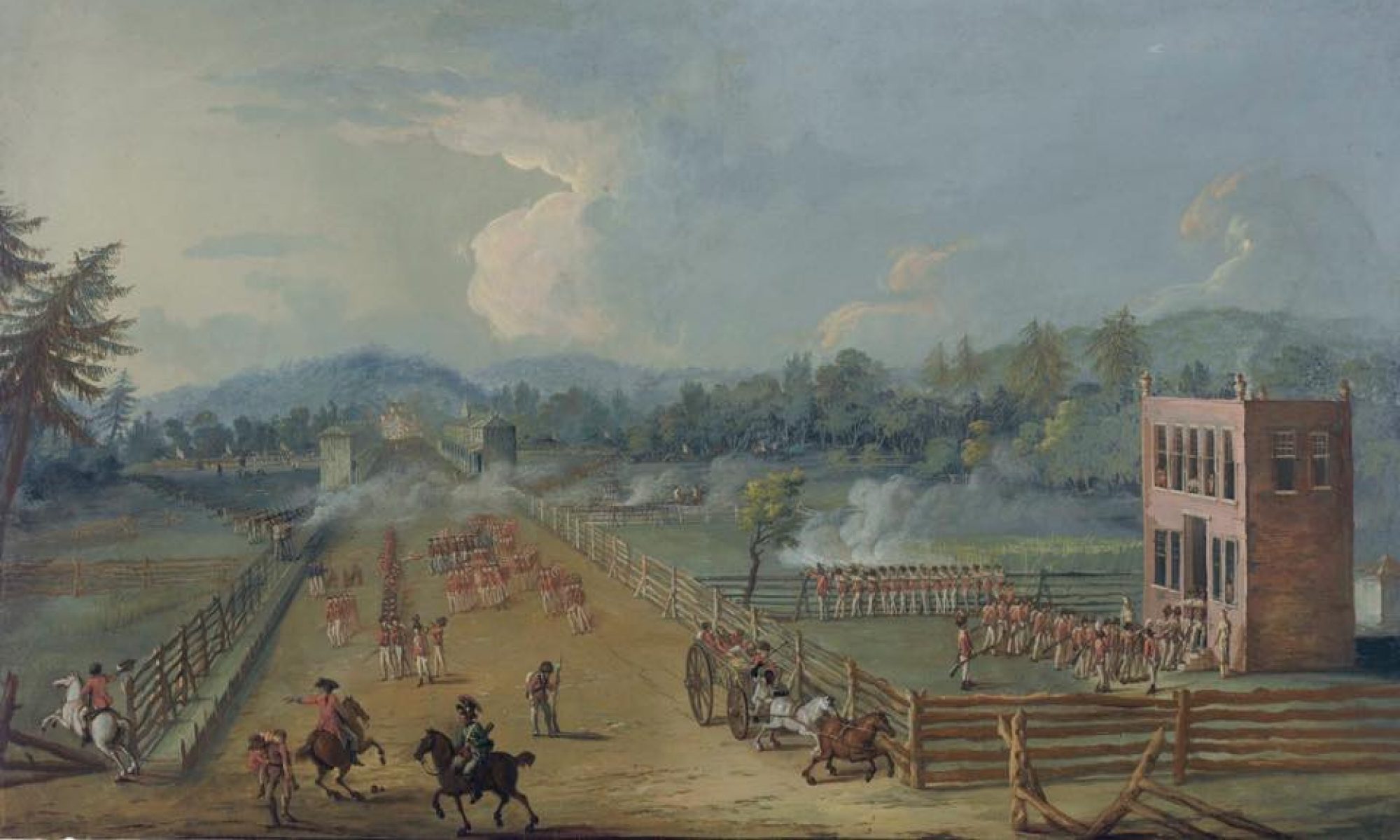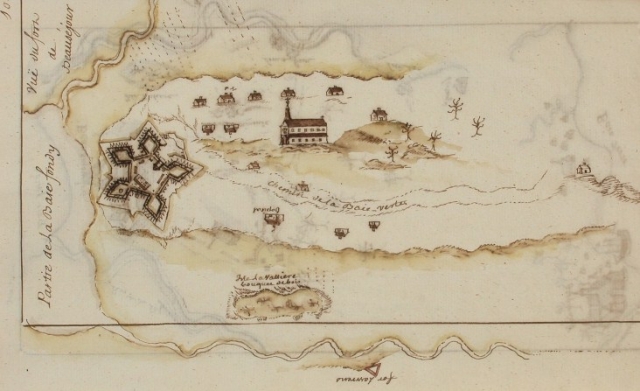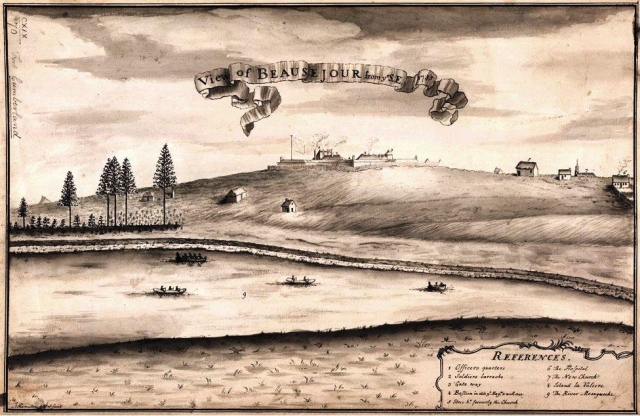Notable Posts and Forts occupied by the 47th Regiment of Foot
Fort Ticonderoga
Crown Point
Diamond Island
Carleton Island
Fort Niagara
Fort Niagara is a fortification originally built to protect the interests of New France in North America. It is located near Youngstown, New York, on the eastern bank of the Niagara River at its mouth, on Lake Ontario. The fort played a significant part in the French and Indian War, and fell to the British in a nineteen-day siege in July 1759, called the Battle of Fort Niagara. The French relief force sent for the besieged garrison was ambushed at the Battle of La Belle-Famille, and the commander of the post, Francois Pouchot, surrendered the fort to the British commander, Sir William Johnson, who initially led the New York Militia. The Irish-born Johnson was not the original commander of the expedition, but became its leader when General John Prideaux literally lost his head, stepping in front of a mortar being test-fired during the siege. The fort remained in British hands for the next thirty-seven years.
Fort Niagara served as the Loyalist base in New York during the American Revolutionary War for Colonel John Butler and his Butler’s Rangers, a Tory militia in the command of the British Army. Lt. Col. William Stacy, a high-ranking officer of the Continental Army, was captured at the attack on Cherry Valley, New York by Butler’s Rangers. He was held captive at Fort Niagara during the summer of 1779. Niagara became notorious for drinking, brawling, whoring, and cheating. Crude taverns, stores, and bordellos sprouted on “the Bottom”, the riverside flat below the fort.
Though Fort Niagara was ceded to the United States after the Treaty of Paris ended the American War of Independence in 1783, the region remained effectively under British control for thirteen years. Only after signing of the Jay Treaty did American forces occupy the fort in 1796.Source: Wikipedia
Detroit and Fort Lernoult
In the fall of 1778, Captain Richard Lernoult, the commander of the British Army at Fort Detroit, feared that that existing encampment would not be sufficient to defend against the oncoming American forces, who, under the command of Colonel Daniel Brodhead, had advanced to within ninety miles. He dispatched his second in command, Captain Henry Bird, to plan a new fortification on higher ground. Work commenced on the project in November 1778, and although construction was beset by problems due to severe weather, by October 1779 a total of 381 British troops were stationed at the new fort.[
The fort was constructed of a 4′ high pile of tree trunks, topped with 7-8′ long sharpened stakes, all of which were covered with an 11′ high earth embankment, 12′ wide at the top and 26′ thick at the base. Outside of the embankment was a 5-6′ deep ditch, 12′ wide and containing an 11-12′ picket.[2]
Although the British had promised to abandon their forts in U.S. territory following the end of the Revolutionary War in 1783, they continued to occupy six of them, including Fort Lernoult. President George Washington sent Chief Justice John Jay to London in 1794 to negotiate a resolution to this and other issues. The Jay Treaty called for the forts to be turned over to the U.S. by June 1796. The British abandoned Fort Lernoult and moved their forces to Fort Amherstburg on the other side of the Detroit River.[3] The Americans occupied the fort on July 11, 1796, under the command of Colonel Jean François Hamtramck with 300 men. Source: Wikipedia
Fort Michilimackinac
Fort Michilimackinac was an 18th-century French, and later British, fort and trading post at the Straits of Mackinac; it was built on the northern tip of the lower peninsula of the present-day state of Michigan in the United States. Built around 1715, and abandoned in 1783, it was located along the Straits, which connect Lake Huron and Lake Michigan of the Great Lakes of North America. Present-day Mackinaw City developed around the site of the fort, which has been designated as a National Historic Landmark. It is preserved as an open-air historical museum, with several reconstructed wooden buildings and palisade.
The primary purpose of the fort was as part of the French-Canadian trading post system, which stretched from the Atlantic Coast and the St. Lawrence River to the Great Lakes, and south to the Mississippi River through the Illinois Country. The fort served as a supply depot for traders in the western Great Lakes.
The French relinquished the fort, along with their territory in Canada, to the British in 1761 following their loss in the French and Indian War, the North American front of the Seven Years’ War. The British continued to operate the fort as a major trading post, but most residents were French and Métis (Ojibwe-French), who spoke predominately French and worshipped at Sainte Anne Church in a small log structure. Other civilian residents included British fur traders, some of whom resided within the fort in the southeastern row house.[
The Ojibwe in the region resented British policies as harsh. On June 2, 1763, as part of the larger movement known as Pontiac’s Rebellion, a group of Ojibwe staged a game of baaga’adowe (a forerunner of modern lacrosse) outside the fort as a ruse to gain entrance. After entering the fort, they killed most of the British inhabitants. They held the fort for a year before the British regained control, promising to offer more and better gifts to the native inhabitants of the area.
The British eventually determined that the wooden fort on the mainland was too vulnerable. In 1781 they built a limestone fort on nearby Mackinac Island. Now known as Fort Mackinac, it was apparently also initially named Fort Michilimackinac. The British then moved related buildings to the island by dismantling them and moving them across the water in the summer and over ice in winter to the island during the next two years. Ste. Anne’s Church was also moved. Patrick Sinclair, the lieutenant governor of Michilimackinac, ordered the remains of the southern Fort Michilimackinac to be destroyed after the move. Source: Wikipedia
Fort Mackinac
Fort Mackinac (pronounced: MACK-in-awe) is a former British and American military outpost garrisoned from the late 18th century to the late 19th century in the city of Mackinac Island, Michigan, on Mackinac Island. The British built the fort during the American Revolutionary War to control the strategic Straits of Mackinac between Lake Michigan and Lake Huron, and by extension the fur trade on the Great Lakes. The British did not relinquish the fort until fifteen years after American independence.
Before 1763, the French used Fort Michilimackinac on the mainland south shore of the Straits of Mackinac to control the area. After the Treaty of Paris (1763), the British occupied the French fort but considered the wooden structure too difficult to defend. In 1780/1781, its lieutenant governor Patrick Sinclair constructed a new limestone fort on the 150-foot (46 m) limestone bluffs of Mackinac Island above the Straits of Mackinac.[ The British held the outpost throughout the American Revolutionary War. Captain Daniel Robertson commanded the garrison on Mackinac Island from 1782 to his death in 1787. Despite the terms of the Treaty of Paris (1783), the British did not officially relinquish the fort to the United States until 1796.
Fort Mackinac later became the scene of two strategic battles for control of the Great Lakes during the War of 1812. During most of the 19th century, it served as an outpost of the United States Army. Closed in 1895, the fort has been adapted as a museum on the grounds of Mackinac Island State Park. Source: Wikipedia



